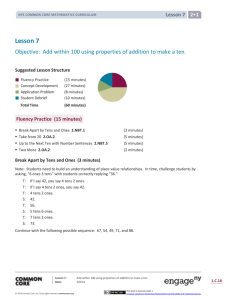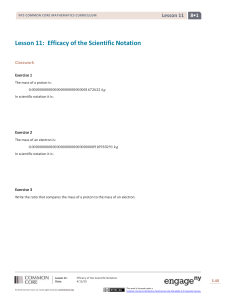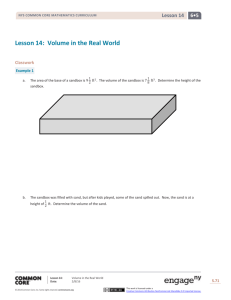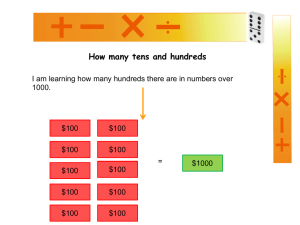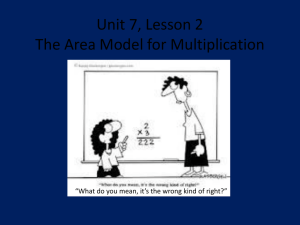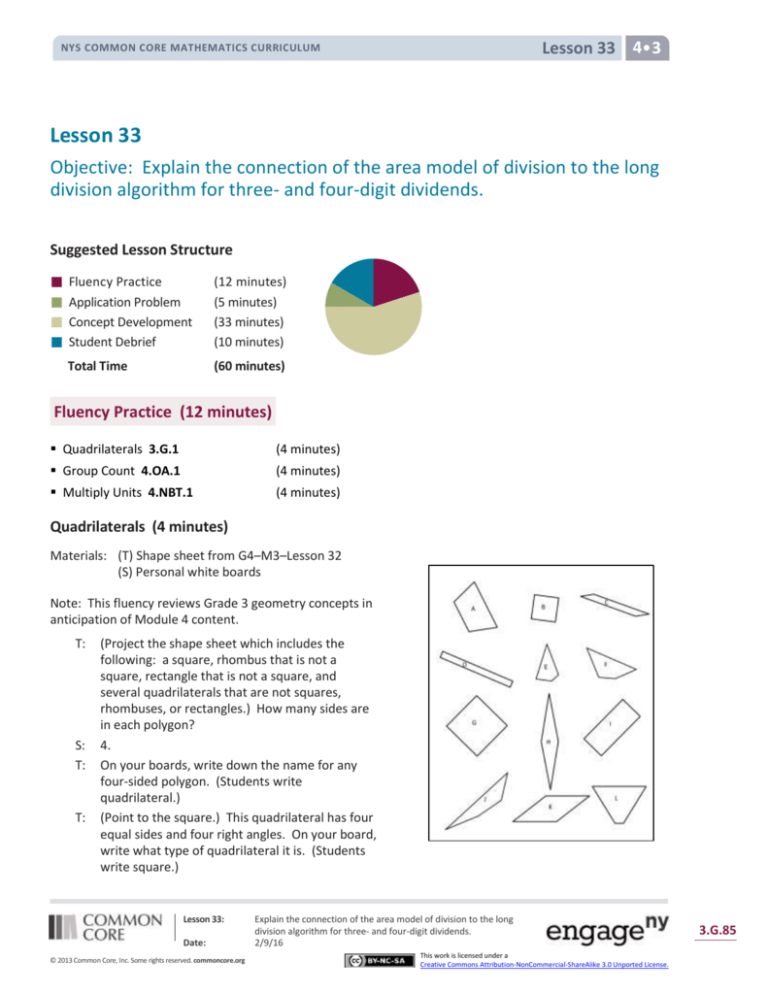
Lesson 33 4
NYS COMMON CORE MATHEMATICS CURRICULUM
Lesson 33
Objective: Explain the connection of the area model of division to the long
division algorithm for three- and four-digit dividends.
Suggested Lesson Structure
Fluency Practice
Application Problem
Concept Development
Student Debrief
Total Time
(12 minutes)
(5 minutes)
(33 minutes)
(10 minutes)
(60 minutes)
Fluency Practice (12 minutes)
Quadrilaterals 3.G.1
(4 minutes)
Group Count 4.OA.1
(4 minutes)
Multiply Units 4.NBT.1
(4 minutes)
Quadrilaterals (4 minutes)
Materials: (T) Shape sheet from G4–M3–Lesson 32
(S) Personal white boards
Note: This fluency reviews Grade 3 geometry concepts in
anticipation of Module 4 content.
T:
S:
T:
T:
(Project the shape sheet which includes the
following: a square, rhombus that is not a
square, rectangle that is not a square, and
several quadrilaterals that are not squares,
rhombuses, or rectangles.) How many sides are
in each polygon?
4.
On your boards, write down the name for any
four-sided polygon. (Students write
quadrilateral.)
(Point to the square.) This quadrilateral has four
equal sides and four right angles. On your board,
write what type of quadrilateral it is. (Students
write square.)
Lesson 33:
Date:
© 2013 Common Core, Inc. Some rights reserved. commoncore.org
Explain the connection of the area model of division to the long
division algorithm for three- and four-digit dividends.
2/9/16
This work is licensed under a
Creative Commons Attribution-NonCommercial-ShareAlike 3.0 Unported License.
3.G.85
Lesson 33 4
NYS COMMON CORE MATHEMATICS CURRICULUM
T:
S:
T:
S:
T:
S:
T:
S:
T:
S:
T:
Rhombuses are quadrilaterals with four equal sides. Is this polygon a rhombus?
Yes.
Is it a rectangle?
Yes.
(Point at the rhombus that is not a square.) This polygon has four equal sides, but the angles are not
the same. Write down the name of this quadrilateral.
(Write rhombus.)
Is the square also a rhombus?
Yes!
(Point at the rectangle that is not a square.) This polygon has four equal angles, but the sides are not
equal. Write down the name of this quadrilateral.
(Write rectangle.)
Draw a quadrilateral that is not a square, rhombus, or rectangle.
Group Count (4 minutes)
Note: This drill prepares students to divide with remainders.
Direct students to count forward and backward, occasionally changing the direction of the count.
Sixes to 60
Sevens to 70
Eights to 80
Nines to 90
NOTES ON
MULTIPLE MEANS
OF REPRESENTATION:
Allow those students who consistently
struggle with group counting at the
pace of the majority of the class to
count by the given multiple on a
personal board and monitor their
progress from one session to the next.
Multiply Units (4 minutes)
Materials: (S) Personal white boards
Note: This fluency reviews Lesson 4’s content.
T:
S:
T:
S:
T:
S:
T:
S:
(Write 3 × 3 = .) Say the multiplication sentence. In
unit form.
3 ones × 3 = 9 ones.
Write the answer in standard form.
(Write 9.)
(Write 30 × 3 = .) Say the multiplication sentence in unit form.
3 tens × 3 = 9 tens.
Write the answer in standard form.
(Write 90.)
Continue with the following possible sequence: 3 hundreds × 3, 3 thousands × 3, 4 ones × 3, 4 tens × 3,
4 thousands × 3, 5 thousands × 2, 5 tens × 4, 5 hundreds × 8, and 8 tens × 6.
Lesson 33:
Date:
© 2013 Common Core, Inc. Some rights reserved. commoncore.org
Explain the connection of the area model of division to the long
division algorithm for three- and four-digit dividends.
2/9/16
This work is licensed under a
Creative Commons Attribution-NonCommercial-ShareAlike 3.0 Unported License.
3.G.86
Lesson 33 4
NYS COMMON CORE MATHEMATICS CURRICULUM
Application Problem (5 minutes)
Write an equation to find the unknown length of each rectangle. Then find the sum of the two unknown
lengths.
3m
600 square m
3m 72 square
m
Note: This Application Problem serves as an introduction to the Concept Development, in which the students
find the total unknown lengths of a rectangle with an area of 672 square meters.
Concept Development (33 minutes)
Materials:
(S) Personal white boards
Problem 1
672 ÷ 3 and 1,344 ÷ 6
T:
S:
T:
T:
S:
T:
S:
Draw a rectangle with an area of 672 square inches
and a width of 3 inches.
(Draw.)
Draw a new rectangle with the same area directly
below, but partitioned to make it easy for you to
divide each part using mental math and your
knowledge of place value. (Allow time for students
to work.)
Share with a partner how you partitioned your new
rectangle.
I made one part 6 hundred, two parts of 3
tens, and one part 12 ones. I made two
parts of 3 hundreds, one part of 6 tens, and one
part 12 ones. I made mine one part 6
hundred and two parts 36.
Draw a number bond to match the whole and
parts of your rectangles.
(Draw bonds as pictured to the right.)
Lesson 33:
Date:
© 2013 Common Core, Inc. Some rights reserved. commoncore.org
Explain the connection of the area model of division to the long
division algorithm for three- and four-digit dividends.
2/9/16
This work is licensed under a
Creative Commons Attribution-NonCommercial-ShareAlike 3.0 Unported License.
3.G.87
Lesson 33 4
NYS COMMON CORE MATHEMATICS CURRICULUM
T:
T:
Find the unknown side lengths of the smaller rectangles and add them to find the length of the
largest rectangle.
Take a moment to record the number sentences, reviewing with your partner their connection to
both the number bond and the area model.
Let the students work in partners to then partition the same area as 2 three hundreds. Those who finish early
can find other ways to decompose the rectangle or work with 1,388 ÷ 6.
T:
T:
S:
(Allow students to work for about four minutes.)
What were some ways you found to partition 1,344 to divide it easily by 6?
We chopped it into 12 hundreds, 12 tens, and 24 ones. We decomposed it as 2 six hundreds, 2
sixties, and 24. I realized 1,344 is double 672. But 6 is double 3 and that’s like the associative
property 672 × 2 × 3, so 1,344 ÷ 6 equals 672 ÷ 3!
T:
S:
How can we see from our bonds that 1,344 is double 672?
When we chopped up the rectangles, I saw 600, 60, and 12 made 672, and the chopped up rectangle
for 1,344 had two of all those!
Explain to your partner why different ways of partitioning give us the same correct side length.
You are starting with the same amount of area but just chopping it up differently. The sum of the
lengths is the same as the whole length. You can take a total, break it into two parts, and divide
each of them separately.
T:
S:
Lesson 33:
Date:
© 2013 Common Core, Inc. Some rights reserved. commoncore.org
Explain the connection of the area model of division to the long
division algorithm for three- and four-digit dividends.
2/9/16
This work is licensed under a
Creative Commons Attribution-NonCommercial-ShareAlike 3.0 Unported License.
3.G.88
Lesson 33 4
NYS COMMON CORE MATHEMATICS CURRICULUM
Problem 2
672 ÷ 3
T:
T:
S:
T:
S:
T:
T:
S:
T:
S:
T:
S:
T:
S:
T:
S:
T:
T:
S:
T:
S:
T:
(Write 672 ÷ 3.) This expression can describe a rectangle with an area of 672 square units. We are
trying to find out the length of the unknown side.
What is the known side length?
3.
(Draw a rectangle with a width of 3.) Three
times how many hundreds gets us as close as
possible to an area of 6 hundreds (point to the
6 hundreds of the dividend)?
2 hundreds.
Let’s give 2 hundreds to the length. (Label 2
lengths of hundreds.) Let’s record the 2
hundreds in the hundreds place.
What is 3 times 2 hundreds?
Six hundreds. (Record 6 below the 6
hundreds.)
How many square units is that?
600 square units. (Record 600 square units
in the rectangle.)
How many hundreds remain?
Zero.
(Record 0 hundreds below the 6
hundreds.) 0 hundreds and 7 tens is?
(Record the 7 tens to the right of the 0
hundreds.)
7 tens.
We have 70 square units left with a
width of 3. (Point to the 7 tens in the
algorithm.) Three times how many
ones gets us as close as possible to an
area of 7 tens?
2 tens.
Let’s give 2 tens to the length.
3 times 2 tens is?
6 tens.
How many square units?
60 square units.
7 tens – 6 tens is?
Lesson 33:
Date:
© 2013 Common Core, Inc. Some rights reserved. commoncore.org
Explain the connection of the area model of division to the long
division algorithm for three- and four-digit dividends.
2/9/16
This work is licensed under a
Creative Commons Attribution-NonCommercial-ShareAlike 3.0 Unported License.
3.G.89
Lesson 33 4
NYS COMMON CORE MATHEMATICS CURRICULUM
S:
T:
S:
T:
S:
T:
T:
S:
T:
S:
T:
S:
T:
T:
1 ten.
That is 10 square units of area to add to 2 square units. The remaining area is?
12 square units!
3 times how many ones gets us as close as possible to 12 ones?
4 ones.
Let’s give 4 ones to the length.
3 times 4 ones is?
12 ones.
Do we have any remaining area?
No!
What is the length of the unknown side?
224 length units.
Review our drawings and our process with your partner. Try to reconstruct what we did step by
step before we try another one. (Allow students time to review.)
We solved 672 divided by 3 in two very different ways using the area model. First we started with
the whole rectangle and partitioned it. The second way was to go one place value at a time and
make the whole rectangle from parts.
Give students the chance to try the following problems in partners, in a small group with you, or
independently, as they are able.
539 ÷ 2
This first practice problem has an easy divisor and a remainder in the ones. Guide students to determine the
greatest length possible first for the remaining area at each place value. This means the remainder will not be
included in the final step.
438 ÷ 5
This next practice problem involves seeing the first area as 40
tens and also has a remainder of 3 in the ones.
1,216 ÷ 4
The final practice problem involves a four-digit number. Like
the previous example, students must see the first area as 12
hundreds and the next area as 16 ones.
Problem Set (13 minutes)
Students should do their personal best to complete the Problem
Set within the allotted 13 minutes. For some classes, it may be
appropriate to modify the assignment by specifying which
problems they work on first. Some problems do not specify a
method for solving. Students solve these problems using the
RDW approach used for Application Problems.
Lesson 33:
Date:
© 2013 Common Core, Inc. Some rights reserved. commoncore.org
NOTES ON
MULTIPLE MEANS
OF ACTION AND
EXPRESSION:
Guide English language learners and
students working below grade level
who may not complete the Problem
Set in the allotted 13 minutes to set
specific goals for their work. After
briefly considering their progress,
strengths, and weaknesses, have
students choose the problems they will
solve strategically. For example, a
learner who is perfecting sequencing
his written explanations might choose
Problem 2. Connect this short-term
goal to long-term goals.
Explain the connection of the area model of division to the long
division algorithm for three- and four-digit dividends.
2/9/16
This work is licensed under a
Creative Commons Attribution-NonCommercial-ShareAlike 3.0 Unported License.
3.G.90
Lesson 33 4
NYS COMMON CORE MATHEMATICS CURRICULUM
Student Debrief (10 minutes)
Lesson Objective: Explain the connection of the area
model of division to the long division algorithm for threeand four-digit dividends.
The Student Debrief is intended to invite reflection and
active processing of the total lesson experience.
Invite students to review their solutions for the Problem
Set. They should check work by comparing answers with a
partner before going over answers as a class. Look for
misconceptions or misunderstandings that can be
addressed in the Debrief. Guide students in a
conversation to debrief the Problem Set and process the
lesson.
You may choose to use any combination of the questions
below to lead the discussion.
In Problem 1, is there another way Ursula could
have represented the division problem with an
area model? Would your number bond in 1(b)
need revision if the area model changed?
Compare your area model in Problem 2(a) to your
partner’s. Is it easier to solve the area model
separating it into 2 parts, 3 parts, 4 parts, etc?
How do you decide how many parts are needed
when building the area model for division?
How are area models, number bonds, and the
long division algorithm connected? Is there a
correct order in which to use them to solve
division problems?
Exit Ticket (3 minutes)
After the Student Debrief, instruct students to complete
the Exit Ticket. A review of their work will help you assess
the students’ understanding of the concepts that were
presented in the lesson today and plan more effectively
for future lessons. You may read the questions aloud to
the students.
Lesson 33:
Date:
© 2013 Common Core, Inc. Some rights reserved. commoncore.org
Explain the connection of the area model of division to the long
division algorithm for three- and four-digit dividends.
2/9/16
This work is licensed under a
Creative Commons Attribution-NonCommercial-ShareAlike 3.0 Unported License.
3.G.91
NYS COMMON CORE MATHEMATICS CURRICULUM
Name
Lesson 33 Problem Set 4
Date
1. Ursula solved the following division problem by drawing an area model.
a. What division problem did she solve?
b. Show a number bond to represent Ursula’s area model and represent the total length using the
distributive property.
2.
a. Solve 960 ÷ 4 using the area model. There is no remainder in this problem.
b. Draw a number bond and use the long division algorithm to record your work from (a).
Lesson 33:
Date:
© 2013 Common Core, Inc. Some rights reserved. commoncore.org
Explain the connection of the area model of division to the long
division algorithm for three- and four-digit dividends.
2/9/16
This work is licensed under a
Creative Commons Attribution-NonCommercial-ShareAlike 3.0 Unported License.
3.G.92
NYS COMMON CORE MATHEMATICS CURRICULUM
Lesson 33 Problem Set 4
3. a. Draw an area model to solve 774 ÷ 3.
b. Draw a number bond to represent this
problem.
c. Record your work using the long division
algorithm.
4. a. Draw an area model to solve 1,584 ÷ 2.
b. Draw a number bond to represent this
problem.
Lesson 33:
Date:
© 2013 Common Core, Inc. Some rights reserved. commoncore.org
c. Record your work using the long division
algorithm.
Explain the connection of the area model of division to the long
division algorithm for three- and four-digit dividends.
2/9/16
This work is licensed under a
Creative Commons Attribution-NonCommercial-ShareAlike 3.0 Unported License.
3.G.93
NYS COMMON CORE MATHEMATICS CURRICULUM
Name
Lesson 33 Exit Ticket 4•3
Date
1. Anna solved the following division problem by drawing an area model.
a. What division problem did she solve?
b. Show a number bond to represent Anna’s area model and represent the total length using the
distributive property.
2. a. Draw an area model to solve 1,368 ÷ 2.
b. Draw a number bond to represent this
problem.
Lesson 33:
Date:
© 2013 Common Core, Inc. Some rights reserved. commoncore.org
c. Record your work using the long division
algorithm.
Explain the connection of the area model of division to the long
division algorithm for three- and four-digit dividends.
2/9/16
This work is licensed under a
Creative Commons Attribution-NonCommercial-ShareAlike 3.0 Unported License.
3.G.94
NYS COMMON CORE MATHEMATICS CURRICULUM
Name
Lesson 33 Homework 4•3
Date
1. Arabelle solved the following division problem by drawing an area model.
a. What division problem did she solve?
b. Show a number bond to represent Arabelle’s area model and represent the total length using the
distributive property.
2. a. Solve 816 ÷ 4 using the area model. There is no remainder in this problem.
b. Draw a number bond and use a written method to record your work from (a).
Lesson 33:
Date:
© 2013 Common Core, Inc. Some rights reserved. commoncore.org
Explain the connection of the area model of division to the long
division algorithm for three- and four-digit dividends.
2/9/16
This work is licensed under a
Creative Commons Attribution-NonCommercial-ShareAlike 3.0 Unported License.
3.G.95
NYS COMMON CORE MATHEMATICS CURRICULUM
Lesson 33 Homework 4•3
3. a. Draw an area model to solve 549 ÷ 3.
b. Draw a number bond to represent this
problem.
c. Record your work using the long division
algorithm.
4. a. Draw an area model to solve 2,762 ÷ 2.
b. Draw a number bond to represent this
problem.
Lesson 33:
Date:
© 2013 Common Core, Inc. Some rights reserved. commoncore.org
c. Record your work using the long division
algorithm.
Explain the connection of the area model of division to the long
division algorithm for three- and four-digit dividends.
2/9/16
This work is licensed under a
Creative Commons Attribution-NonCommercial-ShareAlike 3.0 Unported License.
3.G.96




